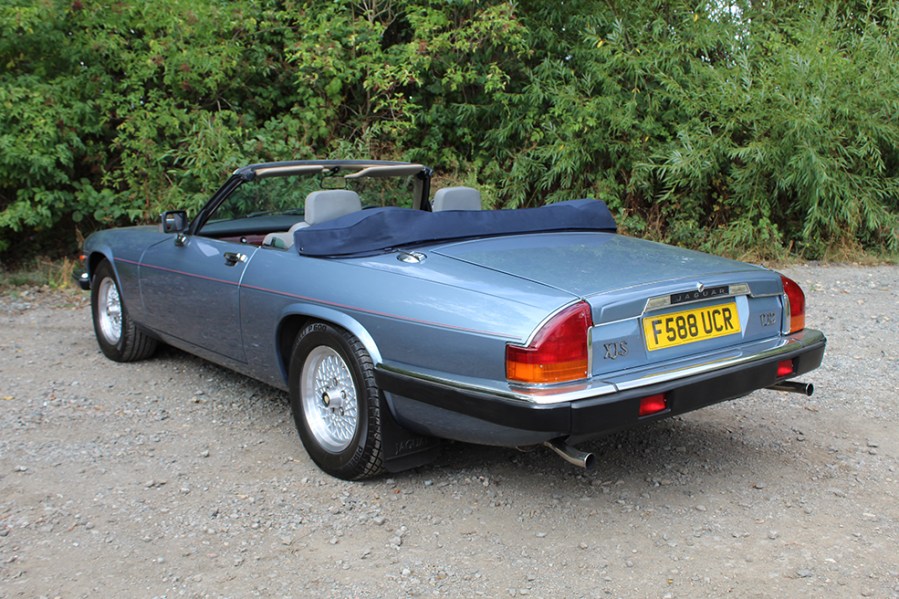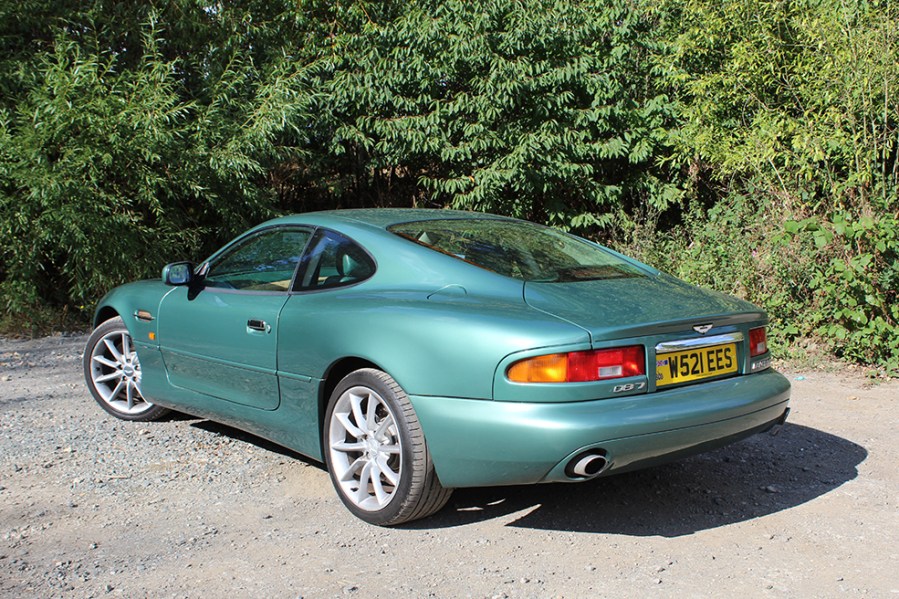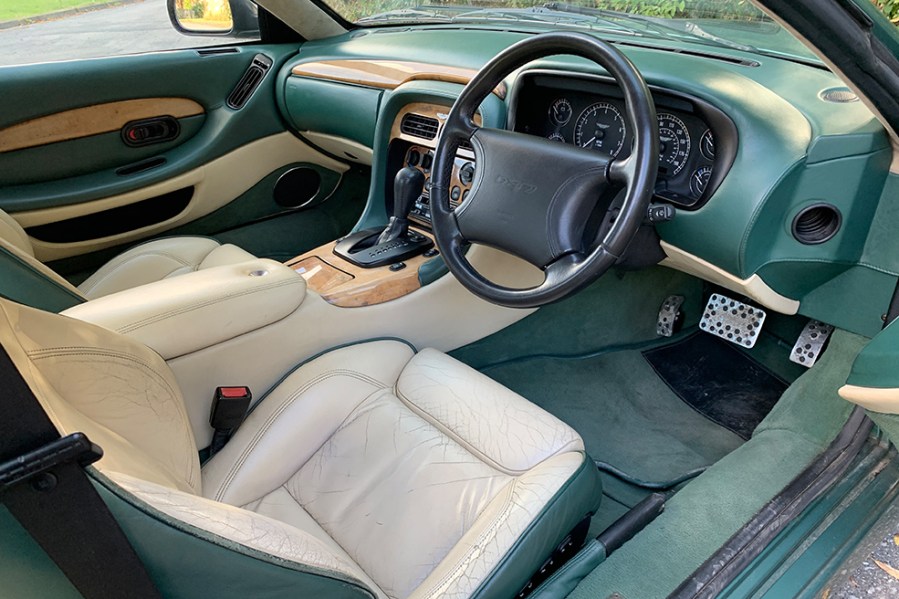While not direct competitors when new, the reducing price gap between the platform-sharing XJ-S and DB7 means they’re closer rivals than ever
Words and images: Jeff Ruggles
When it comes to risk versus reward, the V12 engine is surely the ultimate way to straddle the thin dividing line. On the one hand, a big 12-pot is massively at odds with today’s drive towards economy and environmental restraint, but on the other, it’s an automotive engineering extravagance to stir the soul. And in the Jaguar XJ-S and the Aston Martin DB7 Vantage, two different takes on the V12 can be experienced for a fraction of the price of a new eco-box. But should you indulge, and if so, which of these platform sharers is most worthy of a beleaguered fuel budget?
Jaguar XJ-S
Jaguar’s V12 first appeared in production in 1971 under the nose of the Series 3 E-type, but its origins are in the early 60s, when it was conceived as a quad-cam race engine for the XJ13 Le Mans prototype that ultimately never saw competition. Even so, the race V12 provided useful lessons for a roadgoing version, chiefly that the four cams with their partially geared drive were too noisy for the expected refinement in a Jaguar saloon. As a result, the definitive production version of the V12 offered a 5348cc capacity with a single camshaft on each bank. Despite this it was still a high-performance engine, and being mostly aluminium, weighed only 36kg more than a 4.2 XK six.
Unlike other models, the XJ-S was the only Jaguar to have been conceived and developed with solely the V12 engine in mind. Based on a shortened XJ platform and styled by Malcolm Sayer before being finished off by the in-house jaguar team after his untimely death, the XJ-S was intended to take Jaguar in a bold new direction – specifically, to challenge the Italian makers with its wide-set, low-slung stance – and for that the exotic V12 engine was ideal.
At launch in February 1975, the XJ-S was offered in just two forms: V12 automatic and V12 manual, with the four-speeder discontinued shortly after launch. In truth, it had been offered only as a way to use up the remaining E-type gearboxes. The V12 in launch spec was good for 285bhp and a crushing 294lb.ft of torque, which gave it 150mph pace – the newer car’s better aerodynamics making it faster than the last of the E-Types despite its extra weight.
The new car was a big jump forwards from the E-Type, though many an onlooker was bewildered by the change of direction from sports car to grand tourer. There was no doubt the XJ-S caused a stir, but the styling was divisive to say the least, and fears over a proposed (but never realised) change to American regulations meant an open version was noticeably absent.

The thing that really dented the XJ-S’s appeal, however, was its launch into the aftermath of the 1973 OPEC oil crisis. In urban or spirited driving, single-figure mpg was a reality and a best of around 14mpg was as good as it got. With electrical and reliability issues also added to the mix, the XJ-S teetered on the brink of being axed in 1980.
And yet, it would eventually stay in production for 21 years, thanks to extra variants and well-judged updates. The first major milestone came in 1981, when the original flat-faced cylinder heads were swapped to more conventional HE ‘High Efficiency’ design using Swiss engineer Michael May’s ‘Fireball’ combustion chambers, which meant up to a 57 per cent increase in fuel consumption.
The straight-six AJ6 engine would join the range in 1983 and it’s thought that serious consideration was given to dropping the V12 altogether, but when Ford financed a very extensive overhaul of the XJ-S in 1991 to fill the void of the cancelled XJ41, the V12 remained on offer. Indeed, it gained a new lease of life from May 1993 when it was stroked to 6 litres – not to be confused with a similar 6-litre TWR development.
In the meantime, the wait for an open-top model had initially been fulfilled in 1983 by the XJ-S Cabriolet, although it couldn’t be described as a true convertible thanks to fixed cant rails above the doors and fixed rear quarter windows, plus a T-bar over the cockpit. However, in 1988, the logically-named XJ-S Convertible arrived to replace the XJ-SC, with Jaguar partnering with Karmann to ensure the shell could be made strong enough.
Towards the end of its life, the XJS (now without a hyphen after the facelift) was only available in V12 guise to special order, with the end for the whole range coming in July 1996. Its replacement was the XK8, but the old stager had done more than enough to deserve a strong following.

The XJ-S we have the pleasure of driving is a very attractive V12 Convertible from its debut year of 1988. Settling into the cabin, it quickly becomes apparent that this is not the roomiest of cars, but then I’m not the tallest of humans, so it isn’t really an issue save for the seat rubbing against the centre console. The leather, wood trim and chrome embellishments give the cabin an air of class, and though its 1970s origins mean it looks anything but modern inside, that only adds to the elegant feel. Post-’88 cars like this one have more supportive seats than earlier cars, and they feel like they would keep you comfortable on an overnight dash to, say, Geneva. Being a Convertible without the XJ-S’s trademark rear buttresses, visibility is also much better than with the Coupe, even with the roof up.
In this form the XJ-S weighs more than 1900 kilos and clearly there’s no pretence in being an out-and-out sports car; it’s a grand tourer, and fully commits to it. There’s more than ample grunt when you need it, but the XJS isn’t about straight-line speed – it’s about covering long distances at high speed in relaxed comfort, with its smooth and linear power delivery ensuring bothersome tasks like overtaking are completed with ease. Such is the flexibility of that V12, it responds with complete obedience.
The steering is light but still blessed with feel, while the balance between ride and handling, typically a Jaguar high point, gives the car a far more relaxing demeanour than any BMW or Porsche of the era. To think that this is achieved using a platform developed during the late 1960s is nothing short of incredible, yet the XJ-S can still hustle when required. Granted, that Porsche or a BMW will soon outpace it on track or even a B-road, but the XJ-S can be driven with surprising gusto.
But to reiterate, that isn’t the point – this is car in which to enjoy tree-lined D routes on a trip through France rather than cling on to the apex through Druids. It’s a car for special trips and special occasions rather than thrashing on the daily commute, and for that, it seems to hard to beat. Indeed, the DB7 has a lot to live up to in this company.
Aston Martin DB7
Although the end for the XJS came in 1996, that wasn’t quite the end. Peel away the DB7’s beautiful curvaceous body and you’ll find largely the same chassis and suspension layout. Indeed, that’s because the DB7 started life in the early 80s as a Jaguar project.
The work of one of the company’s designers, Keith Helfet, the XJ40-based car was originally known as the XJ41 and was planned as the eventual XJ-S replacement. However, an overly complicated specification that included all-wheel-drive and a twin turbo version of Jaguar’s AJ6 engine meant the company’s new owner, Ford, deemed it too expensive.
Understandably disappointed, Keith later realised the body would fit the XJ-S platform, meaning the programme could be resurrected for a fraction of the cost. Jaguar’s then engineering director, Jim Randle, showed the idea to Tom Walkinshaw who immediately agreed to put the reborn XJ41 into production. It was still a Jaguar at this point, but Walkinshaw approached Ford suggesting if the car was badged an Aston Martin – which the American giant had also bought in 1992 – it could be sold for a higher purchase price. At the time Aston lacked the resources to develop its own car from the ground up and chairman Walter Hayes was keen to introduce a smaller, lighter and more modern car than its Vantage. Ford readily agreed and despite production being located at the former JaguarSport facility outside Banbury in Bloxham, the project was renamed NPX for Newport Pagnell Experimental.

Walkinshaw instructed former Ford designer, Ian Callum, to further ‘Astonise’ the design, which included bringing the screen further forward and adding a modern interpretation of the famed Aston Martin radiator grille. And, to distance the chassis from that of the XJS, Aston’s engineers added bespoke springs, dampers, bushes and geometry setting to give it a unique set-up.
Due to Ford demanding production costs to be kept low, Walkinshaw raided the giant company’s ever-growing parts bin. This famously included the rear lights from the Mazda 323 and switchgear sourced from Ford itself, while power came courtesy of a supercharged version of Jaguar’s 3.2-litre straight six, producing 335bhp. The only ‘foreign’ parts were the wing mirrors, which were from the Citroën CX (replaced by a new design on V12 cars).
The DB7 was unique for Aston Martin in that it was steel-panelled with composite wings, bonnet, nosecone, sills and bootlid where its predecessors had been largely alloy-panelled, and was also the firm’s first monocoque car. This had an important bearing on production costs and enabled the firm to market it at £78,500 when the Virage had kicked off at £133,000. That was still expensive but made it much more accessible than previous models, and helped contribute to its relatively high sales – sales that are generally reckoned to have saved Aston Martin’s bacon as well as moving the company into a new era.
The Jaguar-derived powertrain did come in for some criticism for being a little coarse and not quick enough, but such views were silenced in 1999 when Aston Martin introduced the Vantage, powered by a mighty 5.9-litre V12 engine. Not to be confused with the Jaguar unit, the 48-valve all-alloy unit was unique to Aston Martin, although development was largely performed by Ford’s powertrain engineering department and Cosworth. It was good for 420bhp and 400lb.ft of torque, which lifted the car’s top speed to a very credible 186mph in six-speed manual form.

Despite the hefty £94,500 price tag, the Vantage had come of age, and was so successful that sales of the Jaguar-powered car were hit hard. Ultimately in mid-1999, production of the straight-six DB7 was discontinued entirely. Indeed, it was in V12 form that the DB7 would see out the rest of its years, with models like the GT, GTA and limited-edition Zagato-styled car launched before car was replaced by the Gaydon-built DB9 in 2004.
The car we have here is a 2000 Vantage Coupe, and though in a perfect world we’d have chosen an open-topped Volante to pitch against the XJ-S Convertible, the pair we have here are more comparable in terms of value. There’s no denying the DB7 is a good looking car in either form, and while the XJ-S has gone from divisive to handsome over the years, the Aston has always been a looker and boasts more kerb appeal than the Jag. It also has the cachet of that famous badge, meaning first impressions are strong.
Get inside though, and things aren’t quite so special. There’s a little more room than the XJ-S, but headroom is still limited. The car’s parts bin origins are also made obvious by the switchgear and interior door handles, while the wood trim looks a bit crude. The DB7 wasn’t produced with the resources or manpower afforded to Jaguar and perhaps needs to be cut some slack, but the overall look and feel of the interior is a touch disappointing and was criticised by contemporary road testers. This particular example has stood up better than many others, but separating veneer, worn leather and leaky door seals are all now common. Yes, the XJ-S can age too, but the corresponding parts for the Jaguar are more easily sourced and massively cheaper.
Thumb the starter button though, and the aura of exotica returns. The V12 Jaguars have always had a somewhat muted exhaust note, clearly engineered for woofling refinement rather than drama, while the Aston rather shouts into life, its busy idle lending it a motorsport edge.

In automatic form as most Vantages are, this still a savagely fast car. Despite weighing in at 1780kg, it sprints to 60mph in five seconds, making it far quicker than the Jag. It boasts even more relentless punch for steaming along sweeping A-roads and overtaking, but the driving experience is not without drama. The massive torque of the V12 easily overwhelms the early ’90s processing power of the Ford-sourced traction control. Full-bore standing starts will still see the car squirrelling up the road, especially in the wet.
Indeed, the aged platform really feels at its limit with 420bhp and extra weight to carry. Curiously, although firmer, the V12 DB7 is twitchier and doesn’t impart the same degree of handling confidence of the XJ-S, or indeed the earlier DB7. At modest speeds it feels competent enough, yet start to push it hard and the front end takes on a boat-like feeling absent in the Jaguar and not helped by the Aston’s larger wheels and tyres. It’s almost as if it’s trying to be both sporty and a grand tourer at the same time, and thus feels compromised. It can’t match the Jaguar’s relaxed nature and feels like it would be more tiring to drive over long distances.
For many owners though, this simply won’t matter. Neither the XJ-S nor DB7 are exactly track day favourites, and few Aston owners will be able to resist a self-indulgent smile as they catch themselves reflected in a shop window. The noise of that V12 while dispatching modern hot hatches at the lights is something you’re never going to grow out of either.
Aston Martin DB7 vs Jaguar XJ-S: our verdict
If you’re a fan of Astons then it may well be that an XJ-S probably won’t even be on your radar, especially as the DB9 is increasingly joining the DB7 as being within reach for marque fans. However, if you’re on the fence, it’s very hard not to choose the Jaguar. The DB7 is the one you tell your friends about, with its gorgeous looks, relative rarity and that prestigious badge, but the XJ-S is just easier to live with, both in terms of parts and maintenance costs and its easy-going demeanour. Yes, you can save a packet on DB7 ownership if you’re clever with parts sourcing and can do the work yourself. Generally speaking though, the Aston is the one that needs deeper pockets to run.
Then there’s the price in the first place. DB7 prices are a bit erratic, but you’re looking at around £16,000 as the entry point for a Vantage at auction, and even then it’s likely to need a whole lot of work. A figure of £25,000 is more realistic for a decent one, and for something nice you can expect to pay considerably more than that. Prices for the XJ-S are even wider ranging thanks to a long production run and greater availability, but it’s possible to get a V12 car for four figures, and really nice ones are only going to be about half the price of a comparable Aston. That’s a situation that’s impossible to ignore.
Given its humble origins the DB7 was a remarkable effort, and its impact on its maker enormous. But it’s not unkind to point out that while the DB7 is a Frankenstein creation of different elements sitting on an XJ-S platform, the XJ-S was designed from start to finish to be an XJ-S. It thus feels like the more accomplished and better realised of the pair, especially in later guises.
Both are smooth, stylish cars that offer so much more than mere transport, but ultimately, it’s the Jaguar that best manages the balance between risk and reward. Of course, whether you should buy either in these eco-conscious days is something we’ll leave down to the individual, but we can’t help but smile at the thought that these full-fat slices of British automotive excess are still here to soundtrack our high days and holidays.






















